Young Storyteller
Award® 2025
For the fifth – and for now, final – edition, Story.one and Thalia are once again on the hunt for the most inspiring storytellers of our time. We believe in the power of young voices that are completely reshaping the book market and paving the way for new trends and bestsellers.
On October 2 at 11 a.m., the YSA25 jury will announce which authors have been nominated for the live final in Vienna. At the same time, the jury will announce the winners of the Thalia Special Prizes for “Most Beautiful Book” and “Most Innovative Book”.
This is what it’s about:
Until August 31, 2025 (24:00 CEST), everyone between the ages of 14 and 35 is invited to publish a book on story.one for free. Aside from the story.on book format (“The TikTok of the publishing industry”), there are no restrictions.
All genres and languages are welcome. From all submissions, the jury will select 10 storytellers to read at the live finale on October 10, 2024, at Thalia in Vienna. The top-selling book will automatically qualify.
Your gateway to the world of books: The live jury will choose the Young Storyteller 2025 winner following their live performance (reading of one story). The winner will receive EUR 7,000, a personal mentoring program, the presentation of their book at the Frankfurt Book Fair and promotional support from Thalia.
In 2025, all finalists will share a total cash prize of EUR 15,500, plus there are numerous special prizes.
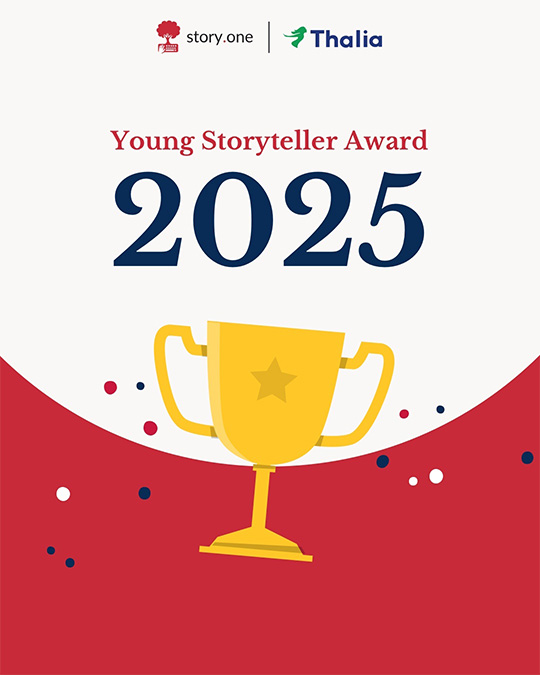
These Prizes Can Be Won

Participants placing 4th to 11th in the live finale will each receive 500 euro.
In 2025, EUR 16,00 in prize money will be awarded.
There is no specific ranking for the longlist.

Everyone is a winner
As in previous years, only one person can become the Young Storyteller, but participating is what counts because …
- You’ll connect with an inspiring community and meet fantastic people.
- Everyone receives a free printed story.one book (with ISBN) – there are absolutely no costs involved.
- You can use everything on the platform, choose from all design options for your cover and upload your own cover image – entering the participation code covers all costs for your first author’s copy (this “voucher” is worth up to 100 euros).
- The rights to your texts remain with you, we receive the distribution rights for the book for at least 6 months.
- You’ll earn a 10% author’s commission starting from the 11th copy sold in stores, with payments made every six months. Sales trends data can be found in your account.
- Special deals for authors when ordering additional author copies from story.one (if you want more than the one free copy).
- We’ll support your journey with numerous podcasts, book hacks (in our newsletter and on our social channels) and you’ll receive a free book-pdf from Hannes Steiners “The story.one Bestsellerformel” which will take your skills to the next level.
- Starting in 2025, we explicitly allow the use of AI tools for creating texts and illustrations. A transparent disclosure of AI usage in the imprint of your submitted book is mandatory.
- The opportunity to showcase your book at Thalia and other prominent platforms. At story.one, anyone can make it onto Thalia’s shelves independently of the Young Storyteller Award and jury decision. With 300+ copies sold in stores, your community will immediately find your book in six selected Thalia flagship stores (Berlin, Vienna, Hamburg, Cologne, Leipzig, and Düsseldorf).

This is what the jury will rate:
Your book should have an original idea, an appealing theme, a captivating title, a professional cover, a concise book description as well as a meaningful author photo and an inspiring biography.
All genres and languages are welcome. Don’t think in terms of patterns, but how you can inspire the jury and readers. Be creative.
While AI tools are permitted, they are not a substitute for genuine creativity. The jury explicitly evaluates your work based on originality, personality, emotional impact, and creative authenticity. It doesn’t matter what tools or resources you use—what matters is that your personal creative signature remains clearly discernible. The use of AI is permitted provided it is transparently disclosed in the imprint.
On 25.09.2025 at 11:00 a.m., all participants will receive written information as to whether they have made it onto the shortlist. These +30 books will then be ranked internally according to our own points system and the points system published here. You can achieve a maximum of 100 points – 30 for the idea, 30 for story quality, 20 for writing style and execution, 10 for book description and author biography and 10 for cover design and title.
50% of all finale spots are reserved for non-influencers (no account with more than 2,000 followers). We want to ensure equal opportunities regardless of the jury voting.
Point system:

Ingo Kretzschmar, CEO Thalia
“I am delighted that we at Thalia are once again part of the Young Storyteller Award this year and that we will be enriching the book market with creative and unique books together with story.one.
Books that touch and inspire their readers in a very special way. Books that have bestseller potential. Let’s start this journey of discovery together! What does it take?
An outstanding story that inspires us all, that moves us and makes us see the world through different eyes. Are you ready?”
The Jury

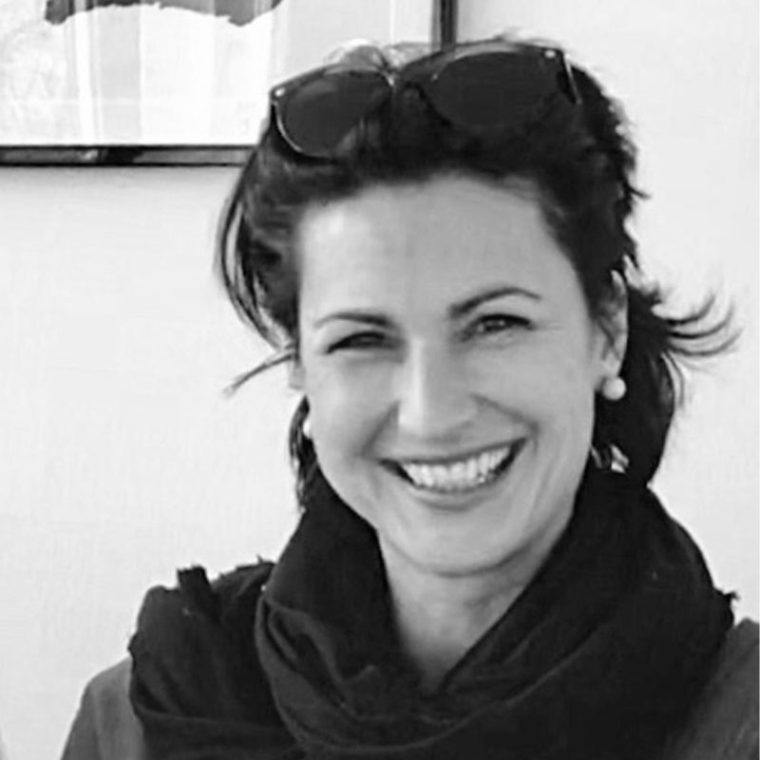
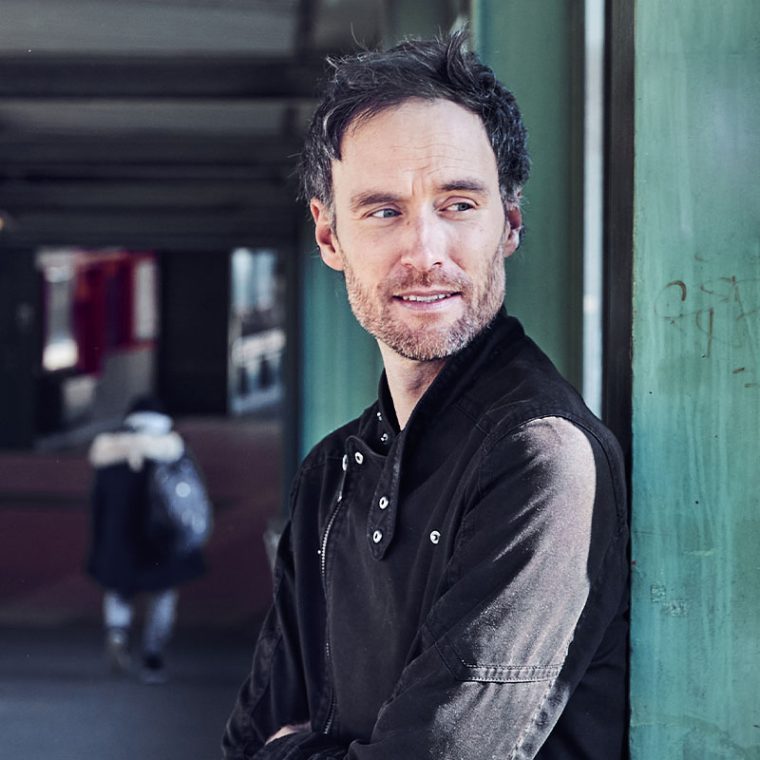
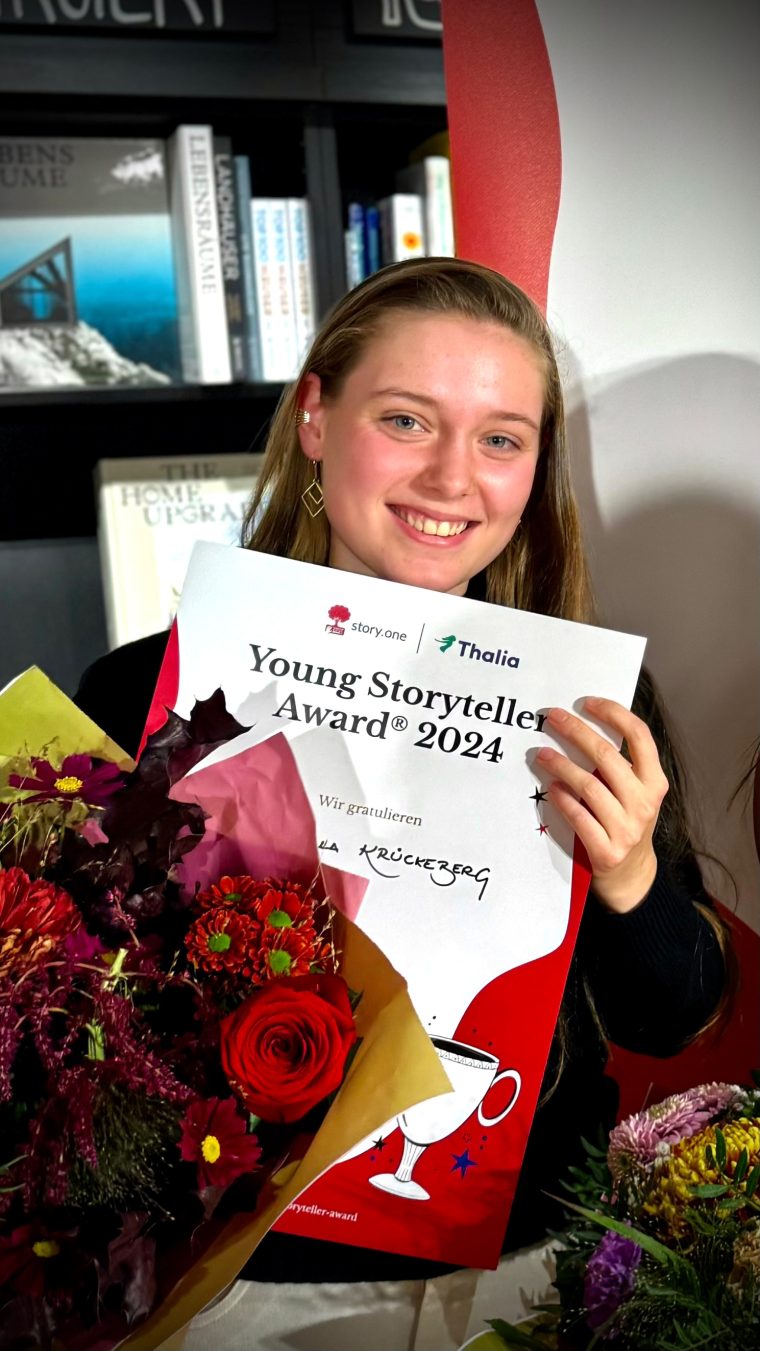
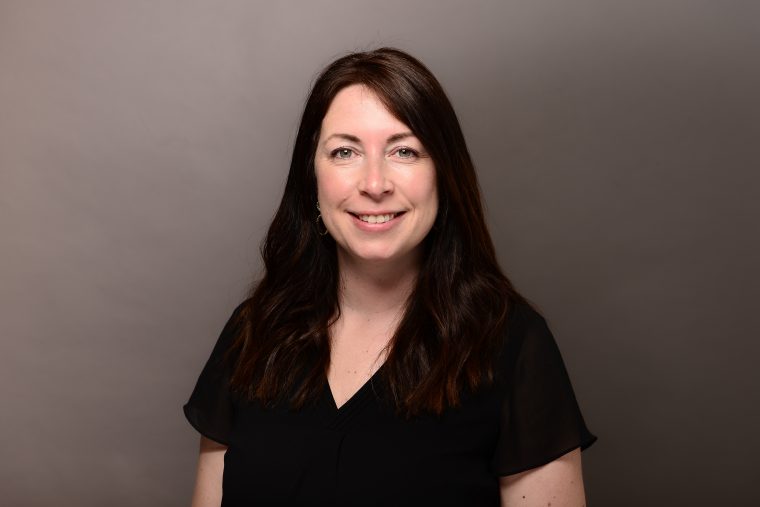


This is how you take part
The Young Storyteller Award is for anyone between 14 and 35 who has a story to tell – storytellers, creative writers, influencers, creators, copywriters… We are convinced that young storytellers need to help shape this exciting new phase of the book industry! And that the best and most creative books have yet to be written.
This is how simple the submission process is:

NEW for 2025: AI and Creativity – Embracing Transparency!
We acknowledge that many of you already naturally incorporate AI tools – for research, imagery, inspiration, or writing. Therefore, this year, we explicitly allow the use of AI tools in your book creation, provided you clearly and transparently disclose this usage in your book’s imprint.
Why are we doing this? Simply put, AI is already a reality. Prohibiting its use would be unrealistic and unenforceable. Instead of hiding its usage, we advocate for honesty.
However, it’s important to note: Our jury explicitly evaluates originality, personality, and emotional depth of your story, not the tools used. Ultimately, it’s the human who wins, never the machine.
Elke Steiner, YSA25 Jury:
“I understand that AI is an emotional and much-debated topic. However, we’ve consciously decided to explicitly allow AI usage. Why? Because AI is already part of our reality—in writing, research, and illustrations. Not permitting it would be unrealistic. Our stance is honesty rather than hypocrisy. Ultimately, what truly excites us is never the tools, but rather the personality, emotions, and the unique voice of the person behind each story.”
Learn more about AI at YSA → FAQ below

Additional Informations
- All information about story.one can be found in the help center, for a quick start watch our Explainer video. We answer special questions about the Young Storyteller Award 2025 in the FAQ at the bottom of the page. Please do not send us a message until you have read the FAQ. We cannot answer all questions – we are a young startup with a relatively small team. We ask for your understanding.
- Always up to date: Subscribe to our newsletter and follow us on social media. You’ll be the first to receive all updates, e.g. when a new podcast goes live. The book pdf “The story.one Bestseller Formula” is free for download.
- After a short review, your book will be published, and you are an author. Your book with ISBN is available in online and bookstores and you receive an author’s fee of 10% (from the 11th copy sold in retail).
This is what former YSA authors say!
They did it. You can do it too!
Vanessa Gerbeth
Top3 YSA 23
“I grew so much beyond myself during the YSA and I was able to take a lot with me as a young author. It was definitely an exciting time and a worthwhile experience.”

Judith Lahfeld
Participant YSA23
“Participating in the Young Storyteller Award was an absolute life changer for me. Not just because my current book is now available at Thalia. I found the courage to finally work as a freelance copywriter. Story.one has opened a lot of doors for me and I promise you, this format is addictive. You made me an author!”

Jakub Debowski
Finalist YSA23
“Impossible. Says the fact. Try it. The dream whispers. And that’s exactly what YSA is all about – making our dreams come true! This feeling of presenting your own book to the world is indescribable. We all have so many dreams but only one life. So what are you waiting for? Try it!”



The Grand Finale 2025
October 10, 2025 – the grand finale event will take place at the Thalia flagship store MH99 at Vienna. Mark this day in your calendar, everyone is invited. You can either be there as a finalist or as a guest in the audience. Get your free ticket now.
You will be informed on September 25 whether you have made it onto the longlist and on October 2 you will find out whether you are one of the finalists. As a finalist, you can bring 4 friends with you and seats will be reserved for them.
At the finale, the 11 finalists (10 selected by Jury + bestselling book) will read a story from their books. The jury will decide directly on site – the grand finale is the selection of the winner of the Young Storyteller Award 2025.
Be part of the final – book your ticket early, places are limited.
Thalia Special Prizes 2025
There are Thalia special prizes for the three most beautiful and the most innovative book, each endowed with a book package worth up to EUR 300. Get inspiration in one of the Story Spots in the Thalia flagship stores in Berlin, Cologne, Düsseldorf, Hamburg, Leipzig and Vienna.
Timetable for the Jury Decision
- Until 31.08. 2025: Submit your story.one book with the voucher code “YSA24”.
- 25.09.2025, 11:00 a.m.: Decision of the jury on the longlist. Information by e-mail to all participants (with YSA25 code) whether they have made it onto the longlist or not.
- 02.10.2025, 11:00 am: Announcement of the 11 finalists and the winners of the special prizes
- 10.10.2025: Live decision at the grand finale in Vienna
Free book-pdf
Unleash the bestselling author in you with the “Hannes Steiner story.one method”: For years he has published one bestseller after another, but now publisher Hannes Steiner is taking on the role of the author himself. In his first book, he sets out to decipher what for many is a closed book: how to write a bestseller. The “story.one bestseller formula” offers not only theoretical knowledge but also practical instructions that can be implemented immediately – the essence of the many years of experience of the two-time Publisher of the Year and visionary founder of story.one. According to him, there is a great book inside each of us, just waiting to conquer the world, and it has never been easier than it is today. So if you’ve ever dreamed of writing a book, the perfect moment is now.
The book is available free of charge as a PDF on story.one for all registered users and also free of charge on thalia.at and thalia.de. It can also be purchased as a hardcover in bookshops for 18 euros.
The Awarding Night
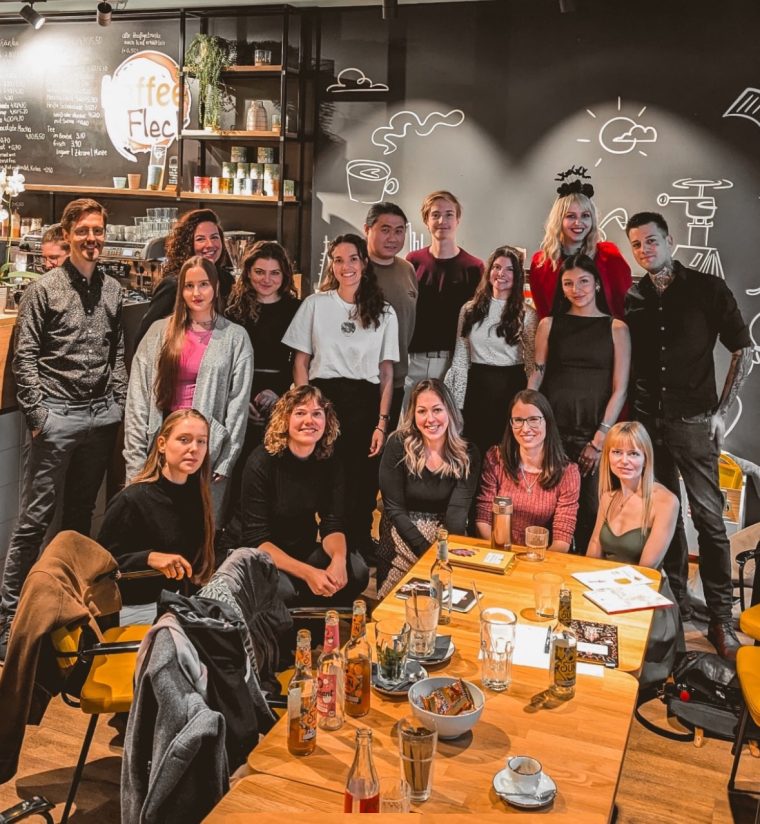
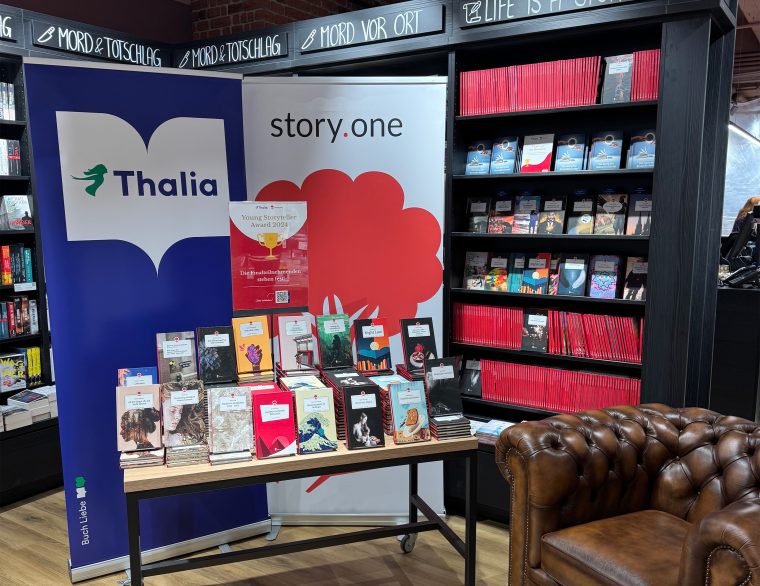
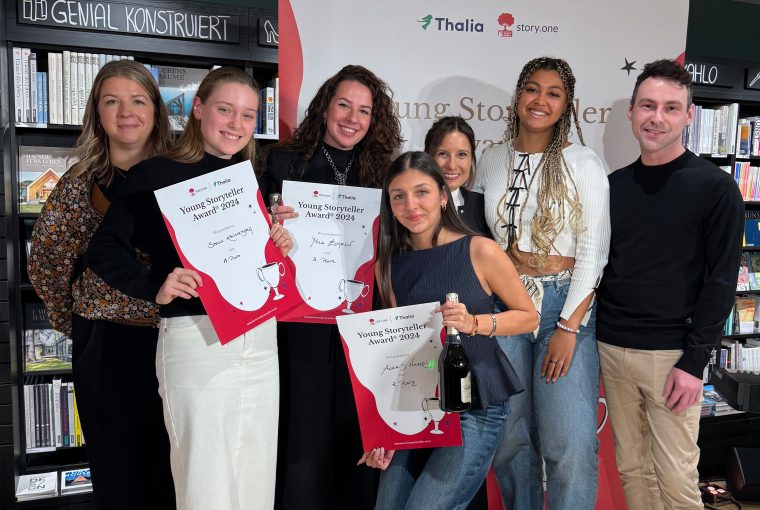
Any more questions?
Additional UX tips (short & valuable)
- Before publication: Take your time to click through the final PDF in the print preview (cover/back cover + inside).
- Contrast & hierarchy: Title > Author’s name – clear weighting increases readability.
- Subsequent corrections: Content errors? Use “Reorder with refresh” (€25), cover image or chapter order require a new ISBN (this is normal in publishing).
Are my books used for model-training purposes?
Our Terms reserve the option to use content to train our own models.
Important: We will only do this after asking you first, and only if you do not object. Your content is never used automatically or without your permission.
Are sensitive company materials protected?
Yes. Corporate content is processed in a GDPR-compliant way and never used for external AI training.
Key points:
- No content is shared with external AI models
- Books can be printed internally without ISBN
- Projects can be deleted anytime
- one uses data only for that specific project
For highly confidential projects, access can be restricted to selected team members.
Can I assign content to specific chapters only?
Yes—after book text generation. Initially label content as fundamental (whole book) or supplementary (topic depth). Later you can upload chapter-specific add-ons (sparingly, to avoid overload).
Can I combine multiple content sources into one book?
Yes — that’s exactly what the Story Editor is built for.
Steps:
- Upload your sources (podcast + slides + interviews + manuscripts)
- Label each file as fundamental or supplementary
- Create a briefing with priorities and gaps
- Generate the proposal — review the merging of materials
- Add missing examples or facts
- Generate the full book and optimize chapter by chapter
Note:
The clearer your content priorities, the more coherent the result.
Find more details in chapter Creating a Book with the Story Editor.
Can I correct my book after publication?
Yes—“Reorder with refresh” (€25) lets you change texts, author bio, or description and republish; the ISBN stays the same.
Cover image or chapter order changes require a new ISBN (industry standard).
Can I correct my book after publication?
Yes—via “Reorder with refresh” (€25): the book switches to draft; you edit texts/bio/description and republish. (Cover image or chapter order changes require a new ISBN.)
Can I create my book in other languages?
Yes—currently German, English, Spanish. Duplicate your project, select the new language, and regenerate book proposal + book texts. Note: It’s a new version, not a 1:1 translation.
Can I later publish my book with a traditional publisher?
Yes. Your texts are yours to reuse—even with a publisher.
The specific story.one book (layout, cover, ISBN) isn’t reused 1:1 externally; a publisher would normally redesign it.
Can I make a book from a keynote or talk—what should I watch out for?
Yes. Upload audio/video (YouTube supported). Check the book proposal/sample chapters to confirm content was recognized correctly—if audio quality is poor, upload your own transcript. For short talks, add slides (text is read) and extra materials; enable enrichment or deep research for contextual examples/data.
Can I make a book from a manuscript?
Yes. Upload the manuscript; for very long files, prioritize relevant passages (upload limits apply).
If you want your own style reflected, add a style sample (20–40k characters).
Can I make a book from a podcast—what’s the best way?
Yes. Upload your audio file or YouTube link—the editor transcribes, extracts key points, and builds chapters.
Recommendations:
- Provide ~60 minutes of audio for enough substance; bundle shorter episodes
- Set focus & audience in the briefing; enable enrichment/deep research if needed
- Optionally upload notes to fine-tune examples and data
Can I make a book from an interview?
Yes. The editor detects interview/talk formats, and can structure Q&A chronologically, summarized, or dialog-style (your choice). For depth, use longer interviews or bundle several, and specify focus in the briefing.
Can I manually edit Story Editor texts?
Yes. Open any auto-generated chapter in the Text Editor and edit line by line.
Can I mix content types in one project?
Yes. The editor reads multiple formats in parallel and links related information when context is clear. Key remains: filter for relevance and mark sources as fundamental vs. supplementary.
Can I paste text from Word?
Yes—copy & paste from Word or other tools. The editor shows instantly if a chapter exceeds its maximum length. Tip: remove extra paragraph marks/spaces—they count toward length.
Can I publish privately only (no ISBN)?
Yes—disable ISBN at checkout. Your book will be printed privately for you and not listed in stores.
Great for gifts, private projects, or corporate publications.
Can I pull my book from the market?
Yes—choose “Discontinue book sales” in your profile for €25. It remains visible in databases but can’t be ordered (“no longer available”). Already printed copies stay in circulation.
Can I turn interviews or interview series into a book?
Yes — interviews contain rich, authentic knowledge. The Story Editor can structure them chronologically, thematically, or in dialogue style.
How it works:
- Upload audio/video or transcripts
- Set focus in the briefing
- For multiple interviews: upload a 1-page overview of core topics
- Review the proposal and choose the structure you prefer
- Generate the book and adjust chapter focus or length
- Add notes or background information if needed
Tip: Combining several interviews often creates a stronger book.
Find more details in chapter Creating a Book with the Story Editor.
Can I turn scientific papers or studies into an accessible non-fiction book
Yes. The Story Editor transforms complex research into clear, readable chapters without losing accuracy.
Steps:
- Upload papers (PDF or text) and abstracts
- Define your audience (laypeople, students, experts)
- Enable deep research if you want extra context
- Mark core papers as fundamental
- Review the proposal — check structure, examples, title
- Generate the book and refine chapter depth
Note:
Upload a style sample if you want to keep your academic tone.
Find more details in chapter Creating a Book with the Story Editor.
Can I update, shorten, or republish an existing book?
Yes. You can upload an existing book, manuscript, or older edition as source content and recreate it with the Story Editor — updated, condensed, or restructured.
Possible versions:
- Updated edition (new data, examples, cases)
- Condensed edition (shorter “mindprint” version)
- Extended edition (additional chapters)
- New structure (for a different audience)
- Design refresh (new cover, new format)
How it works:
- Upload your manuscript or PDF
- Mark relevant files as fundamental
- Set your goals in the briefing (e.g., “shorten”, “update”, “restructure”)
- Regenerate proposal + book texts
- Adjust chapters manually
- Publish as a new edition with a new ISBN (if layout/structure changes)
Note:
You must own the rights to your existing book.
Can I upload and analyze my own writing style?
Yes. Upload a 20–40k character sample. The editor learns syntax, devices, and vocabulary; if desired, you can highlight specific quirks (e.g. typical phrases) via watch-outs/briefing. Readability & consistency for your audience remain a priority.
Can I upload my own images?
Yes—for cover and interior. Use ≥225 DPI (recommended 300 DPI) and 2 cm safety margins so nothing gets cropped. For people photos, obtain consent.
Can I use the Story Editor only for a book proposal or outline?
Yes. Many authors, publishers, and companies use the Story Editor solely to generate a professional book proposal — as a basis for publisher discussions or further manuscript work.
A proposal includes:
- 3 title suggestions
- A clear positioning of the book
- A complete table of contents
- 2 sample chapters
- An author bio
- A book description
Why this is useful:
- You get a complete structure in ~20 minutes
- Ideal for pitching to publishers, agents, or corporate stakeholders
- Less effort than generating a full book
Note:
You can expand the proposal into a full book anytime.
Can I write on my phone?
Yes. The Text Editor is fully mobile-optimized—write, edit chapters, design the cover, and publish right from your phone.
Can we apply our corporate language in the Story Editor?
Yes. In the briefing, at “Any special watch-outs?” you can add:
- corporate wording
- do’s & don’ts
- terminology rules
- tonality guidelines
- examples
- internal communication standards
The Story Editor then follows these consistently across all chapters.
Find more details in chapter Creating a Book with the Story Editor.
Can we create multiple books or entire series as a company?
Yes — many corporate clients produce entire series.
Examples:
- “CEO Insights” — annual strategy books
- “Leadership Toolbox” — multiple playbooks
- “Innovation Series” — per product area
- “Culture & Values” volumes
- “Clinic-to-Life” — research translated for patients
- “Academy Series” — educational materials
How series work:
- Create a series briefing
- Upload assets per book
- Define a consistent look & feel
- Scale printing & distribution
- Optionally create a series landing page
Can we document our corporate event or conference as a book?
Yes — this is one of the most popular corporate use cases. Keynotes, panels, workshops, and interviews are turned into a cohesive event book.
Best suited for:
- Annual conferences
- Kick-offs
- Leadership meetings
- Product launches
- Innovation days
- Offsites
- Anniversary events
How it works:
- Upload videos, transcripts, slides
- Story Editor creates a proposal (e.g., Prologue → Keynotes → Panels → Learnings)
- Add program details, results, highlights
- Generate the book and distribute internally or externally
Tip: Event books are excellent for PR, stakeholder communication, and recruiting.
Can we publish corporate books in retail?
Yes — if desired.
Suitable for:
- thought leadership
- brand storytelling
- industry reports
- client books
- employer branding
Once a book reaches 300+ sales, it is automatically reported to Thalia and may be placed in Thalia flagship stores.
Can we use books purely internally — without an ISBN, as an internal company product?
Yes. Companies can order books:
- without an ISBN
- for internal use only
- without any retail listing
- with a custom cover
- in any quantity
This is ideal for:
- internal trainings
- onboarding
- offsites
- team communication
- project wrap-ups
- academy programs
All content remains entirely within the company.
Do I have to submit legal deposit copies?
Some countries (e.g., Germany, Austria) require legal deposit copies for national/library archives. Usually relevant only at higher volumes or public interest.
Responsibility lies with you; for questions, email [email protected].
Do I still need to fact-check?
Yes—recommended for critical data/facts (especially if you enabled enrichment/research). That ensures numbers, quotes, and references meet your standard—just like any professional non-fiction book.
Does story.one claim copyright on AI-generated content?
No. story.one claims no copyright on Story Editor-generated content.
Legal status of AI-generated texts may vary by jurisdiction; in any case, rights remain with you/the original uploader.
Does the Story Editor replace a ghostwriter — what’s the difference?
No. The Story Editor does not replace a ghostwriter. Instead, it handles the time-consuming parts of the writing process: structure, outline, first draft, and audience adaptation.
Your content still comes from you — from your podcast, talk, manuscript, interview, or notes.
What the Story Editor does:
- Structures your material into clear chapters
- Creates a book proposal (titles, ToC, 1–2 sample chapters)
- Adapts style, tone, and readability for your audience
- Adds examples and explanations if desired
What you as the author decide:
- Message, perspective, and examples
- Target audience & tonality
- Final approval and fine-tuning
- Personal experience & expertise
In short:
You remain the author. The Story Editor is a structured tool — not a ghostwriter replacement and not a text factory.
How can I assign special tasks to the story editor?
At “Any special watch-outs?”, you can give the Story Editor additional instructions on what matters to you when creating the book texts, for example:
- language preferences, e.g. use gender-neutral terms such as “educator” instead of “female/male teacher”
- editorial requirements, e.g. follow the communication guidelines: (add guidelines)
- tense preferences, e.g. write the entire book in past tense
- additional notes on your personal writing style, e.g. use typical phrases/wordings in my writing sample or e.g., use my kind of humor
- consistent terminology, e.g. avoid “kindergarten teacher” and replace it with “preschool teacher” or “educator”
- consistent spelling, e.g. ensure uniform spelling for terms, names, or abbreviations
- general do’s and don’t
How can I delete stories or books?
- Delete a story: in your profile in story menue > Edit (only if it’s not part of a published book)
- Remove a story from a book: delete chapters in the book draft
- Delete a book: only if unpublished
- Discontinue book sales: €25—book remains visible in databases but is no longer orderable
How can I help shape what comes next?
Give feedback (email), publish public stories, join collaborative projects, and connect on social channels.
Success stories on our website show how authors use the Story Editor—and invite you to create yourself.
How can I provide transparency about the sources of my book?
In addition to the copyrights for images (cover, bookblock), you can add the sources for the book in the imprint (e.g., your podcast, your keynote, an interview, etc.). If your book was created using “General Knowledge” or “Deep Research”, you can activate a source link (checkbox) to share with your readers.
We recommend sharing all of this information transparently in the imprint (even though this is not required under the EU AI Act).
How can I track the sales of my book on story.one?
In your account, the Sales Trend feature shows all copies that have been ordered by retailers, produced, and delivered to retailers.
Please note:
- It reflects retailer orders, not final consumer sales. Retailers often hold stock; later sales from inventory don’t change the trend.
- Returns or unpaid/uncollected copies are deducted from royalty calculations.
Exact sales figures are reported twice a year (June 30 & Dec 31) by retail partners, validated, and used as the basis for royalty payouts. Author copies ordered directly from story.one are not included.
Additionally, check the story.one bestseller lists at Thalia Germany and Thalia Austria to see how your book compares to other story.one titles.
How do feedback (Q&A) and loops work?
After generation, the editor asks chapter-specific reader questions (“test-reader Q&A”). You can regenerate (20 credits/chapter) or edit manually. That way, you improve iteratively without starting from scratch.
How do I adapt the texts for different target audiences?
Define age, level of knowledge, profession, and interests. The editor adjusts vocabulary, examples, and terminology, tailored precisely for the target group—from broad and accessible to highly specific and detailed (e.g., for the target groups “people interested in medicine”, “general practitioners (GP)”, or specialists in internal medicine). Also include your target audience’s cultural background or country. This helps the Story Editor fine-tune the book texts to best match your readers’ context.
Tip: You can create multiple versions of your book from the same content — for different audiences and in different languages. Simply duplicate the project and adjust the audience or language settings in the briefing.
How do I choose a good title (incl. title clearance)?
A good title is short, memorable, audience-fit. The Story Editor suggests titles, but you must check title clearance (e.g., thalia.de, buchhandel.de, search). The editor does not run clearance, and suggestions might already exist.
Tip: test 2–3 favorites with your network; the book draft has a checkbox to disable title hyphenation.
How do I create an English or Spanish edition of my book?
You can generate a new language version at any time. Each language becomes a new edition, with its own tonality and audience adaptation.
Steps:
- Duplicate your finished project
- Choose the desired language in the briefing
- Generate proposal + book texts
- Review style, clarity & cultural context
- Finalize & publish (with a new ISBN)
Note:
This is not a literal translation — it’s a fully re-created version optimized for the new audience.
How do I design my cover?
Choose from 2,000+ free images or upload your own. Keep a 2 cm safety margin and remember very dark images print darker (brighten if needed).
One-time options at first order: e.g., vignette swap (€10), back cover tweak (€5), own image with quality check (€25).
Minimum sizes: front (portrait) ≥ 1500×2000 px, front+back (landscape) ≥ 3000×2000 px
How do I keep track of length and structure?
In the Text Editor, you see in real time how many pages your chapter has. With the print preview “Check Layout”, you can see exactly how your text will look in the final book. This makes it easy to shorten, split into two stories, or add paragraphs until everything fits perfectly.
How do I know if my content is sufficient?
Before generating the book proposal, the editor checks if amount/depth fits your goal and flags too much/too little. During the book proposal, content is aligned to scope and depth; afterwards you can adjust (more content, tweak settings).
How do I pick the right style, tonality, and balance?
Choose style (structure/mode), tonality (rhetorical color), and balance (facts vs. narrative) to fit audience & topic. Extreme combinations may seem inconsistent — it’s better to stay coherent or vary only slightly.
How do I reach support?
Email [email protected] with:
- your username or email
- a short issue description (screenshot helps)
- the title/name of the affected story or book
Support typically replies within 1 business day.
How do I turn a keynote or talk into a book
Keynotes already have a strong message and structure — perfect for the Story Editor.
Steps:
- Upload video/audio (or YouTube link)
- If audio quality is low, add your manuscript or slide text
- Set your target audience clearly in the briefing
- Review the proposal and highlight sections to expand
- Add examples, cases, or data
- Generate chapters and refine them in the Text Editor
Note: Talks under 20 minutes work best when combined with slides + notes.
Find more details in chapter Creating a Book with the Story Editor.
How do I turn my podcast into a book?
Podcasts work extremely well as source material. The Story Editor identifies themes, narrative arcs, and personal insights and turns them into a structured non-fiction book.
How it works:
- Upload your audio file or YouTube link
- (Optional) Add your own transcript for maximum accuracy
- Define audience, must-have topics & tone in the briefing
- Enable enrichment or deep research if you want more context
- Review proposal + sample chapters
- Generate the full book and refine chapters as needed
Tip: If you have many short episodes, bundle 2–4 with similar topics.
Find more details in chapter Creating a Book with the Story Editor.
How do I turn notes, presentations, or corporate materials into a book?
Ideal for teams, projects, knowledge transfer, and corporate publishing.
Steps:
- Upload slides, notes, reports, or concept documents
- Mark core documents as fundamental
- Define the audience (team, clients, leadership)
- Generate the proposal — check structure and content gaps
- Enable enrichment or deep research if examples or case studies are needed
- Generate the book and refine in the Text Editor
Tip: For larger organizations, a mindprint format works particularly well.
Find more details in chapter Creating a Book with the Story Editor.
How do I use print previews effectively?
Three layers:
- Quick view in the Text Editor → live page spread (1–3)
- Check layout in the Text Editor → print-like PDF per story
- Print preview in the book draft → final PDF incl. cover & interior
Check: extra line breaks (count!), 2 cm margins, image brightness, title legibility, QR codes.
How do I write a strong book description?
The book description is your shop window in the marketplace (max. 1,000 characters). It should spark curiosity without giving too much away. Tips:
- Start with emotion or an open question
- Present the theme/mood, not a synopsis
- Use 1–2 topic keywords for findability
- End with an open promise or thought
How do I write my author bio?
Show who you are and why you wrote the book—personal, authentic, inviting. Example: “Born in Vienna, at home in stories. After years in marketing, I now share what I wish I’d read earlier.”
Aim for a voice that makes readers want more from you.
How do spelling and grammar checks work?
In the Text Editor, select your language (German, English, French, Spanish, Italian) to enable the matching spell/grammar check.
For final polishing, use the integrated WProofreader tool.
How do Story Editor credits work, and what packages are available?
Credits are used for each generation/regeneration:
- Book proposal: 200 credits
- Book proposal incl. deep research: 400 credits
- All book texts (12–17 chapters): 600 credits
- Regenerate a chapter: 20 credits
Credit packages (buy anytime):
- 1,000 → €50
- 2,200 → €100
- 5,000 → €200
How does AI-powered corporate publishing work with story.one?
story.one enables companies to convert existing materials — talks, strategy documents, interviews, playbooks, research files — into a professionally structured book within hours.
Typical project flow:
- Define goals (e.g., training, employer branding, thought leadership)
- Upload assets (slides, videos, reports, interviews, transcripts)
- Create a briefing (audience, tonality, must-haves, corporate language)
- Generate proposal (title, ToC, sample chapters)
- Generate book texts, review, refine
- Print & distribute via Thalia/retail or internally (no ISBN)
Typical results: leadership books, onboarding guides, culture books, method books, event books, knowledge compendiums.
Find more details in chapter Creating a Book with the Story Editor.
How does print-on-demand work at story.one?
Books are produced only when ordered.
- No warehousing, no upfront stock
- Local print partners produce near the buyer → faster delivery, lower CO₂
- Sustainable, fair, and flexible production
How does publication work?
Click “Review & Publish.” We check:
- Content: compliance with community standards (e.g., no discriminatory content, rights respected)
- Technical: all required fields present (title, language, cover, description, min. 12 chapters)
- If using your own cover image: extra data quality check (resolution, margins, printability)
Next, you buy at least one author copy (from €18). Your book receives an ISBN, is listed in retail databases, and becomes orderable worldwide.
How does story.one prevent errors or hallucinations in the book?
The Story Editor deliberately does not work like a classic text generator.
Instead, it uses a systematic safety approach designed to reduce hallucinations and increase factual accuracy.
How we prevent hallucinations:
- Asset prioritization: Your materials (audio, manuscripts, slides, papers) are always treated as the primary source.
- Neurosymbolic rules: A rule-based system defines clear relationships, chapter structures, and audience logic that limit hallucinations.
- Audience filters: The AI may only use information that makes sense for the selected audience.
- Deep research with source link: When enabled, the editor provides transparent sources so you can verify facts.
- Feedback loops: After generation, the editor asks reader-style questions that help detect gaps or unclear parts.
- Manual refinement: You can edit, lock, or regenerate any chapter at any time.
Recommendation:
As with any editing process, you should briefly cross-check important data, numbers, and quotes.
The AI handles 90–95% of the workload, but you remain the person responsible for the content.
Find more details in chapter Creating a Book with the Story Editor.
How does story.one protect my content and data?
- GDPR-compliant storage on secure EU servers
- No sharing of your content with third parties
- Your data does not train external AI models
- Only you decide what gets published
How does the Story Editor work, step by step?
- Create a Book Briefing (goal, must-have topics, tone, target audience)
- Upload assets (text/audio/video/links)
- Generate the book proposal (title suggestions, detailed ToC, 2 sample chapters, bio, description)
- Generate the book texts (typically 12–17 chapters), then refine/regenerate as needed
- Book draft & publication (cover, images/quotes, spell check)
How does the Story Editor’s credit system work?
- Book proposal: 200 credits (with Deep Research 400 credits)
- All book texts (12–17 chapters): 600 credits
- Regenerate a chapter: 20 credits
Small free re-generations are fair-use limited; paid generations are always available.
How does the Text Editor work?
The Text Editor is your online writing studio on story.one. Write chapter by chapter with live preview, automatic formatting, and page counter. Each chapter can have up to three pages of text.
It’s simple—on laptop or smartphone.
How fast can I get a print-ready book with the Story Editor?
- First book proposal: ~20 minutes; with “Deep Research” ~60 minutes
- All book texts: up to 60 minutes for usually 17 chapters (depends on content amount/depth)
With final checks and layout, you can be print-ready the same day.
How is story.one different from traditional publishers or self-publishing platforms?
- Speed: With the Story Editor, your book can be print-ready the same day.
- Simplicity: No long editorial or publisher processes—you start right away.
- End-to-end: From upload to book proposal, book texts, cover, printing, and distribution—all on one platform.
- Human-centric: We’re not an “AI book factory,” but a place where people publish with AI support.
- Transparency & fairness: You keep full rights, pricing is clear, no hidden contracts.
How long do production and delivery of author copies take?
- Production: 2–5 business days
- Delivery: +2–14 days depending on destination
In DACH, expect ~10–14 days total; longer worldwide.
How long is my data stored?
As long as you keep the project. If you delete a project, all data is permanently removed.
How much are author copies and what volume prices apply?
- 1 copy: €18
- ≥ 7 copies: €14 each
- ≥ 50 copies: €12 each
- ≥ 300 copies: €8 each, free shipping
- ≥ 1000 copies: €5 each, free shipping
How much content do I need for a complete book?
There is no hard minimum — books can also be created from limited material. The more of your own content is available, the more the result is based on your input (instead of additions).
Upper limit: approx. 250–300k characters per project, 1 GB per file.
How much do I earn per copy sold?
Royalties on trade sales (not author copies):
- 11–3,000 copies: 10% of gross retail price (€1.80 per book)
- 3,001–10,000 copies: 12%
- 10,001+ copies: 16%
How sustainable is story.one (production, logistics)?
Print-on-demand, local print partners, and efficient logistics reduce overproduction, transport, and CO₂.
Books are printed where they’re ordered—fast, resource-friendly, no warehousing.
I’m a podcaster — what does creating a book with story.one do for me?
Podcasters benefit greatly from turning their existing audio content into a book.
The Story Editor identifies themes, argumentation lines, and personal elements and transforms them into a coherent non-fiction book.
Benefits for podcasters:
- Condense your content for loyal listeners
- A new format to grow reach, community & monetization
- Series are possible (“Best of Season 1”, “Best of Interviews”, etc.)
- A book as an entry point for new audiences
How it works:
- Upload your audio or transcript
- Define the focus/theme (e.g., one main topic or several episodes)
- Generate the proposal → refine as needed
- Generate chapters and add missing elements if necessary
- Design the cover → publish
Find more details in chapter Creating a Book with the Story Editor.
I’m a scientist — how does story.one help me publish my work?
The Story Editor turns complex scientific content into clear, accessible chapters — without losing precision.
It’s ideal for research projects, theses, talks, preprints, or collections of papers.
Benefits for researchers:
- Complex content → clear, understandable chapters
- Precise audience targeting (laypeople, students, professionals)
- Use of existing papers, abstracts, presentations, and slides
- Very fast publication (days instead of months)
How it works:
- Upload your papers, abstracts, or slides
- Define your audience (scientific vs. general-interest)
- Generate the proposal → review the structure
- Generate chapters and adjust where needed
- Add images, graphics, or QR codes → publish
Find more details in chapter Creating a Book with the Story Editor.
I’m a speaker or trainer — how can I use story.one?
story.one is perfect for speakers and trainers who want to turn their talks, keynotes, or workshop content into a professional book. The Story Editor extracts core messages, structures them logically, and turns them into a clear non-fiction format.
Benefits for speakers/trainers:
- A book increases visibility & credibility on stage
- Ideal as a high-quality giveaway at events
- Reuse existing talks without rewriting everything
- Perfect for lead generation (e.g., QR codes, checklists)
How it works:
- Upload your talk as audio/video/slides
- Define audience & tone in the briefing
- Generate the proposal → review → refine
- Generate the book texts
- Design the cover & finalize → publish or print for events
Find more details in chapter Creating a Book with the Story Editor.
Is story.one suitable for internal handbooks, playbooks, and onboarding guides?
Absolutely. story.one is ideal for any format requiring clear, compact, practical knowledge.
Used for:
- Onboarding guides
- Leadership playbooks
- Culture & values handbooks
- Brand story books
- Method & process guides
- Sales playbooks
- Product explanation books
Recommended workflow:
- Upload slides, documents, interviews
- Define corporate language & guidelines in the briefing
- Enable enrichment if examples or benchmarks are needed
- Generate chapters and review internally
- Add images, graphics, QR codes
Note:
Internal books can be printed without ISBN and used purely inside the company.
Find more details in chapter Creating a Book with the Story Editor.
UX tips: Publication & distribution
- Check the final PDF (print preview) before publication.
- If the target is commercial publication → activate ISBN.
- If the target is private printing → deactivate ISBN.
Keep the 300 milestone in mind: it can be a springboard to Thalia shelves and PR opportunities for you.
What about taxes?
- Germany: tax-free side income up to €410/year
- Austria: tax-free side income up to €730/year
- Switzerland: all income must be declared
For businesses: from €400 royalties, you can provide a VAT ID; invoicing may use reverse-charge.
What are the image specs?
- Cover portrait (front): ≥ 1500×2000 px
- Cover landscape (front+back): ≥ 3000×2000 px
- DPI: ≥225, recommended 300
- Image size: portrait (cover, interior) 16.8 cm × 24.5 cm, landscape (cover) 31.1 cm × 24.5 cm
- Safety margin: ≥ 2 cm all around (trim)
What are the two ways to create a book—Text Editor and Story Editor?
At story.one you have two ways to create a book:
- Text Editor: You write yourself — chapter by chapter, with live preview, spell check, and simple handling.
- Story Editor: You upload existing content (e.g. audio, manuscripts, presentations) and the Story Editor creates a book proposal and then your book texts — structured, consistent, and adaptable.
Both paths lead to the same result: a printed book with ISBN, cover, and worldwide distribution.
What briefing settings exist and how do they affect results?
Three clear options:
- Focus on your content → minimal additions, maximum use of your assets
- Enrich with general knowledge → brief contextual add-ons
- Use deep research → deeper, related additions (~45–50 min, 200 credits)
These settings control how much external information enters—transparent and similar to a human research/editorial workflow.
What can I customize in the book?
After text creation (DIY or Story Editor), you finalize your book with cover, dedication, title, description, and up to 18 color pages. Each chapter has one extra page for an image/quote/QR/short text.
Later changes are possible via “Reorder with refresh” (€25)—except cover image and chapter order.
What can I do if I have (almost) no content—quick ways to create it?
Proven (human & IP-clean) paths:
- Record a 60–90 min voice memo with your thoughts/stories/data
- Do a friend interview (audio)—often easier, more fluent
- Outline or mind-map, then record a voice note
- Optionally add Wikipedia articles (cite in imprint) and enable enrichment/deep research
The editor analyzes, structures, and writes—just like a human ghostwriter would with your materials.
What can I do if the upload of a link (Wikipedia, YouTube, Google Docs) doesn’t work?
Wikipedia: The Wikipedia site may be temporarily overloaded. Try uploading the link again later.
YouTube: The Story Editor can process videos or audios that have available transcripts/subtitles. If none are available (and you own the rights), create your own transcript and use it as a text file. In some cases, the content may be blocked in your country (geo-blocking), which prevents the link from being processed.
Google Docs: The Story Editor can process a Google Doc if it is publicly accessible. Make sure your sharing settings are: “Anyone with the link” / “Editor”
Other links aren’t auto-supported at the moment.
What can I use the Story Editor for?
Books from manuscripts, keynotes, podcasts, interviews, reports, corporate/brand stories, and more. The editor analyzes your material, structures it into chapters, and writes in your chosen style and tone.
What content can I upload (text, audio, video, presentations, links)?
- Text: .docx, .txt, .pdf, Markdown
- Audio/Video: .mp3/.m4a/.mp4/.wav/.webm (YouTube links supported)
- Presentations: PowerPoint/Keynote (only slide text is read)
- Links: Wikipedia, YouTube (with transcript), public Google Docs (“Anyone with the link”)
Tip: Mark files as fundamental (central) or supplementary (additional).
What do I need credits for—and how many?
Credits are required to work with the Story Editor. A typical project:
- Book proposal (200) + full book generation (600) = 800 credits
- Additional credits may be needed for chapter re-generations or Deep Research.
What does “Human-Centric Book Publishing” mean at story.one?
“Human-centric” means people come first—not AI. The Story Editor helps you turn your ideas, content, and experiences into a book 300x faster, while your voice and perspective remain intact.
That’s why we deliberately don’t speak of “AI books,” but of books by people that become easier, faster, and more accessible thanks to modern technology
What does “human-centric publishing” mean in practice?
You stay at the center: your content, your perspective, your decisions. The Story Editor accelerates the path to a fact-based non-fiction book, but rights, voice, and control remain with you.
No “AI books”—books by people, supported by technology.
What does a typical corporate project look like? (Short version)
- Define goal
- Collect content
- Create briefing
- Generate proposal
- Feedback round
- Generate book texts
- Final edits & design
- Print & optionally retail listing
Duration: 1–5 days, depending on scope.
Find more details in chapter Creating a Book with the Story Editor.
What does it cost to publish a book with story.one?
Using story.one is free. Costs occur only for:
- the mandatory purchase of one author copy at publication (from €18)
- optional extras (e.g., cover upgrades, error-correction reorder, market withdrawal)
- using the Story Editor, which requires credits
What extras (quotes, QR codes, color pages) are possible?
Each chapter has 3 text pages + 1 extra page for image, quote, QR code, playlist link, graphic, or short text—or keep it blank.
Up to 18 color pages are included at no extra cost. Ensure rights/permissions for quotes/QRs/people photos.
What happens when my book reaches 300 sales?
Once your book sells 300 copies in retail (not author copies), story.one notifies Thalia. Your book can then be featured in up to six Thalia flagship stores (e.g., Vienna, Hamburg, Cologne, Düsseldorf, Leipzig, Berlin).
A major boost for visibility, PR, and readings.
What if a chapter exceeds the 3-page limit?
Either trim manually (check layout) or regenerate the chapter (20 credits) with a note on what to tighten. Watch blank lines/line breaks—they count toward length.
What if I have too little content?
Enable enrichment or use deep research; then fact-check. Alternatively, upload more assets, reduce the number of chapters, or choose a more narrative style.
What if I have too much content?
Curate up front: mark relevant items as fundamental, others as supplementary; remove duplicates. For very large sets, condense core statements or split into multiple projects.
What is “Deep Research” and when should I use it?
It works like a researcher: from your assets + briefing, it collects public, thematically relevant information (incl. timely aspects where useful) and integrates it contextually. Ideal when content is scarce or you want more depth. Effort: ~45–50 min, 200 credits (book proposal incl. research 400 credits).
What is a Book Briefing—any tips for a great one?
It’s your instruction to the editor: goal, audience, must-have topics, deeper dives, tone/tonality, watch-outs (do’s/don’ts), optional personal anecdotes. Plain language is enough—no prompt tricks required. Precision yields targeted results; freedom yields creative proposals. It mirrors a human editorial/ghostwriting process—just faster.
What is MeinBuch@Thalia?
MeinBuch@Thalia lets you display your book for at least one month in a Thalia store.
- Requirement: you order 50 or more copies for yourself via story.one (+ 3 free promo copies)
- Choose among participating Thalia stores (e.g., Berlin, Düsseldorf, Hamburg, Cologne, Leipzig, Vienna)
- The store orders copies and places them prominently
You’re not buying shelf space—you qualify through engagement (great for readings, local reach, social media)
What is the fair-use rule?
Free micro-regenerations (e.g., titles, bio) are limited because they consume compute. If you hit the cap, the free service pauses briefly for one hour.
Paid generations (e.g., chapters or book proposal) are always available.
What is the idea behind the Story Editor?
The Story Editor turns your non-fiction content (text, audio, video, slides, links) into a complete book—from book proposal to chapters to press-ready output. Goal: publish knowledge and experience quickly, precisely, and in the right tone for your audience, while you stay in control (briefing, re-generations, manual edits).
What languages can I write in?
Any left-to-right language works. Multilingual books are possible. Set the correct language in the editor to activate matching spell-check (German, English, French, Spanish, Italian).
What makes story.one unique?
story.one is the first end-to-end platform that turns your existing content into a professional non-fiction book in just a few hours. Whether it’s a podcast, interview, manuscript, talk, or notes—the Story Editor creates a structured book with ISBN, cover, printing, and worldwide distribution.
What’s unique is our blend of human-centric publishing (you remain the author; AI is just a tool) and a unified, high-quality book format that works consistently everywhere.
What rights do I have for e-books and audiobooks?
story.one currently provides print-on-demand only. You keep all rights and can publish e-books or audiobooks elsewhere anytime.
What role does AI play in the Story Editor exactly?
The Story Editor works with a combination of Large Language Models and a neurosymbolic structure developed together with ExtensityAI.
The AI does not “just generate text”. Instead, it analyzes your material, organizes it logically, builds chapter structures, and adapts style, tone, and audience targeting — always based on your own content.
In short:
- The AI does not write in your place,
- it translates your knowledge into a professional non-fiction format.
How the Story Editor uses AI:
- Content analysis: It identifies themes, arguments, examples, and relationships.
- Structuring: It creates a proposal, chapter logic, and depth of content.
- Audience adaptation: Vocabulary, complexity, and tone are adjusted to the selected audience.
- Style guidance: If desired, the editor can incorporate your personal writing style.
- Context & examples: When needed, it adds data, models, or explanations (“enrichment” / “deep research”).
Important:
You remain the author at all times. The AI is a tool — not the sender.
Find more details in chapter Creating a Book with the Story Editor.
What should I consider regarding personal rights?
If you write about real people or use photos of people, get consent first. For interviews or quotes, ensure you have the necessary rights—otherwise anonymize or pseudonymize.
What story.one writing styles are available?
There are predefined non-fiction styles (e.g. factual-analytical, advisory, narrative, business-like, scientific, modern). Each style has a default balance between information and storytelling — adjustable for your project. Examples/characterizations can be found directly in the briefing dialog.
What tips help when writing individual chapters?
- Start with a hook (question, image, thought)
- Build a clear arc
- Use paragraphs for readability
- End with an insight or takeaway
- Avoid repetition—chapters are short and precise
What topics and genres are possible?
You can publish any non-fiction that moves, inspires, or informs people. Typical examples:
- Guides, business books & essays
- Personal stories & memoirs
- Science & society explained clearly
- Interview and experience collections
- Corporate and brand stories
Note: If you use the DIY Text Editor, you can also use the format for fiction (e.g., short stories or poetry slams).
What’s special about the story.one book format?
All story.one books use a unified, high-quality format:
- 12–17 chapters, each with up to 3 pages of text
- One extra page per chapter for an image, quote, or QR code
- Compact hardcover (5×8 inches / approx. 12.7 × 20.3 cm)
The format is designed so books can be read in about an hour, but leave a lasting impact. Through standardization, production, distribution, and readability are consistent worldwide — no matter where your book is ordered.
What’s story.one’s vision?
We want everyone to have a voice—and to make knowledge, experience, and ideas quickly accessible as real books.
Human-centric publishing: people remain the authors; AI is the tool that brings structure, speed, and quality.
What’s the role of the compact book format (5×8 inches)?
The fixed format (~12.7 × 20.3 cm, hardcover) gives clarity:
- 12–17 chapters, each max. 3 pages
- +1 extra page per chapter (image/quote/QR)
- ~60–80 pages total—quick to read, focused in content
It keeps design, production, and global distribution consistent—and readers know what to expect.
When and how are royalties paid out?
You receive royalties starting from the 11th trade sale. Payouts are semi-annual (cut-offs June 30 and Dec 31). About three weeks later, your balance appears in your author profile, and you can request payment (IBAN).
When will my book be available in stores?
Usually within 1–3 days it’s visible in major online shops (e.g., Thalia, Amazon, Hugendubel). Bookstores can order it too. Each order triggers print-on-demand—no stock, no waiting.
Where will my book be available (Thalia, Amazon, bookstores)?
Your book can be ordered from 6,000+ online shops—incl. Thalia, Amazon, Osiander, Hugendubel, and international retailers.
It’s also orderable in physical bookstores: once customers ask, booksellers can order it directly.
Which company departments benefit most from story.one?
Key corporate users include:
- HR / People & Culture — onboarding, culture, leadership guides
- L&D — training books, workbooks
- Communications — brand story, PR formats, event books
- Marketing — product books, thought-leadership
- Sales — playbooks, case study books, tools & frameworks
- R&D — “paper-to-people” for internal/external books
- Executive Board — CEO letters, strategy books, transformation stories
The Story Editor is also well-suited for creating company chronicles and corporate histories — such as anniversary books, transformation stories, or brand-history books..
Which devices can I use with story.one?
story.one is fully web-based and works on all common devices—PC, laptop, tablet, smartphone. Writing, cover design, and publishing are mobile-ready.
Who are story.one’s partners?
We work with strong partners, including:
- Thalia – Europe’s largest bookseller for visibility & availability in retail
- Libri – one of Europe’s leading book logistics providers for efficient distribution
- ExtensityAI – research partner behind the Story Editor technology
We’re continually expanding partnerships in culture, education, science, and media.
Who is story.one for?
story.one is for anyone who wants to turn thoughts, experiences, or expertise into a book—without a publisher, without hurdles, and without long wait times. Typical users:
- Coaches, speakers & entrepreneurs who want to share their message
- Scientists & experts who want to publish quickly
- People with personal stories, memoirs or experiences
- Teams or organizations that want to create a book together
In short: anyone can make a book—even with no prior writing experience.
Who is the Story Editor for?
For everyone who wants to publish compact, well-founded, and timely non-fiction books: coaches, entrepreneurs, scientists, teams—as well as anyone who wants to efficiently turn existing content into book form.
Who owns the rights to my texts and books?
You do. story.one only receives a simple license to publish and distribute your book. You can reuse your content anytime—e.g., as an e-book or audiobook elsewhere.
Why can’t I see the “Review & Publish” button?
The button appears only when all mandatory fields are present:
- Title
- Language
- Cover
- Dedication
- Genre
- Book description (min. 1 character)
- Biography
- At least 12 chapters
- Imprint
If anything is missing (see the “?” hints), the button won’t appear.


